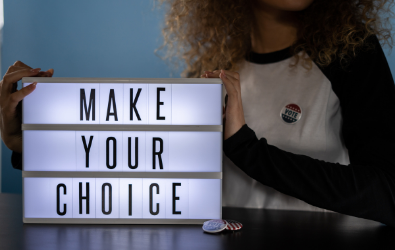We are exactly one week from arguably the most important presidential election in the history of the United States. With issues of healthcare, race, social injustice, climate change and the ongoing pandemic primarily driving public opinion, now it’s more important than ever for nonprofit organizations to take action to ensure their staff members, volunteers and those they serve are speaking up on the issues that matter the most to their communities.
Earlier this month, Teak shared ways in which organizations can leverage their social media platforms to “Post Your Vote,” raising awareness about how and why they should participate in the election. Today, we explore why nonprofit voting advocacy matters and other ways in which organizations can empower people to cast their ballots.
As a reminder, nonprofits cannot endorse a candidate, make a campaign contribution, rate, or rank candidates, or let candidates use their facilities or resources, unless they are made equally available to every candidate. All messaging and actions must remain nonpartisan.
Why should nonprofits engage the public in this way?
We know nonprofit voting advocacy engagement matters.
From an organizational standpoint, nonprofits have the established presence and trust in communities, especially those often overlooked by pollical campaigns, to educate constituents about the issues and ensure their communities know how, why, and when to vote. In turn, this type of engagement often helps build their brand reputation, inspires people to become community advocates and sometimes gets the attention of the candidates with shared interests themselves.
From an election standpoint, we know this type of engagement does boost voter turnout. According to the 2018 Engaging New Voters Reporter, nonprofits that engage the public in nonpartisan voter engagement activities boost ballots cast in their communities by 11 percent. These voters are twice as likely to represent nonwhite households with estimated annual incomes of $30,000. And the number of Black, Latinx and Asian individuals who voted increased 13 to 16 percent compared to those not contacted by nonprofits.
What can nonprofits do now?
I recently attended a virtual training on this very topic through the Junior League of Boston. Debi Lombardi, Director of Partner Engagement for Nonprofit VOTE, shared the following seven things nonprofits can do now through Election Day:
- Promote early voting opportunities – encourage people to mail their ballot back or to utilize mailing options to ensure people’s voices are heard and to avoid potentially long lines on election day.
- Distribute sample ballots – show people what to expect to see on their local ballot as sometimes residents are more knowledgeable about national campaigns than local candidates and issues.
- Mobilize staff and volunteers – nonprofit teams can reach out to prospective voters personally through texts and phone calls to encourage them to vote without endorsing specific candidates.
- Educate voters on the voting process – ensure people know how, when, and where to vote locally and encourage them to make their own plan to cast their ballot.
- Encourage and remind people to vote – utilize national holidays and events, such as Vote Early day (Oct. 24), in messaging materials to remind folks to get out and vote.
- Advertise Election Day help – offer resources and supporting materials to help people register and make a plan to vote, such as the resources available through Nonprofit VOTE.
- Plan an Election Day celebration – host an event (virtually this year) to celebrate voter participation in the election. Ensure people that it is okay if we do not have results at the end of the day as mail in ballots will be accounted for after Election Day.
The Teak team encourages all individuals, nonprofits, and for-profit organizations to let their voices be heard and vote, whether it be by mail, early voting or on Election Day. See you at the polls!


